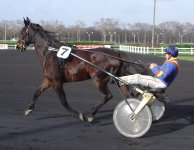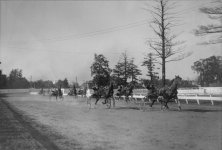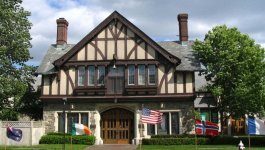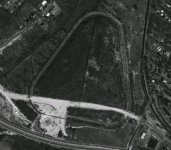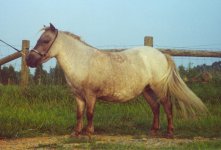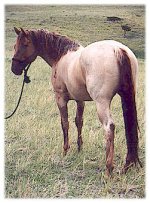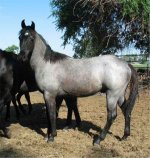♘امیرحسین♞
♘ مدیریت انجمن اسب ایران ♞
Harness racing is a form of horse-racing in which the horses race in a specified gait. They usually pull two-wheeled carts called sulkies, although races to saddle (trot monté in French) are still occasionally conducted, especially in Europe.
The Breed
In most jurisdictions harness races are restricted to standardbred horses although cold-blooded horses are raced in Scandinavia and European horses often have partly French or even Russian lineages. Standardbreds are so called because in the early years of the Standardbred stud book only horses who could trot or pace a mile in a standard time, or whose progeny could do so, were entered into the book.
Standardbreds have proportionally shorter legs than thoroughbreds and longer bodies. They also are of more placid dispositions, as suits horses whose races involve more strategy and more re-acceleration than do thoroughbred races.
The founding sire of today's standardbred horse was Messenger, a gray thoroughbred brought to America in 1788 and then purchased by Henry Astor, brother of John Jacob Astor. From Messenger came a great-grandson, Hambletonian 10 (1849-1876), who gained a wide following for his racing prowess. However, it is his breed line that he is most remembered for. From Hambletonian 10's four sons, the lineage of virtually all American Standardbred race horses can be traced.
Races
Races can be conducted in two differing gaits; trotting and pacing. The difference is that a trotter moves its legs diagonally, right front and left hind, then left front and right hind striking the ground simutaneously, whereas a pacer moves its legs laterally, right front and right hind, then left front and left hind striking the ground simultaneously.
In continental Europe races are conducted exclusively between trotters, whereas in Australia, Canada, New Zealand, the United Kingdom, and the United States races are also held for pacers.
Pacing races constitute 80% to 90% of the harness races conducted in North America. The horses are faster and, most important to the bettor, less likely to break stride (a horse which starts to gallop must be slowed down and taken to the outside until it regains stride). One of the reasons pacers are less likely to break stride is that they often wear hopples or hobbles, straps which connect the legs on each of the horse's sides. The belief that hobbles are used to create this gait is a misconception. The pace is a natural gait, and hobbles are merely an accessory to support the pace at top speed.
Most harness races start from behind a motorized starting gate. The horses line up behind a hinged gate mounted on a motor vehicle which then takes them to the starting line. At the starting line the wings of the gate are folded up and the vehicle accelerates away from the horses. The other kind of start to race is a standing start, where there are tapes across the track behind which the horses either stand stationary or trot in circles in pairs in a specific pattern to hit the starting line as a front. This enables handicaps to be placed on horses according to class with several tapes, usually with 20 metres in between. Some European, Australian and New Zealand races start using tapes.
The sulky (informally known as a bike) is a light two-wheeled cart equipped with bicycle wheels. The driver carries a long, light whip which is chiefly used to signal the horse by tapping and to make noise by striking the sulky shaft. There are strict rules as to how and how much the whip may be used.
North America
Almost all North American races are at a distance of one mile, and North American harness horses are all assigned a "mark" which is their fastest winning time at that distance. Harness races involve considerable strategy. Track size plays an important part here; on the smaller half-mile and five-eighths rings common to harness racing early speed becomes a more important factor, while the longer stretch runs of seven-eighths and mile tracks lend themselves more favorably to closing efforts. Usually several drivers will contend for the lead out of the gate. They then try to avoid getting boxed in as the horses form into two lines -- one on the rail and the other outside -- in the second quarter mile. They may decide to go to the front, to race on the front on the outside ("first over", a difficult position), or to race with cover on the outside. On the rail behind the leader is a choice spot, known as the pocket, and a horse in that position is said to have a garden trip. Third on the rail is an undesirable spot, known on small tracks as the death hole. As the race nears the three-quarter mile mark, the drivers implement their tactics for advancing their positions – going to the lead early, circling the field, moving up an open rail, advancing behind a horse expected to tire, and so on. Unlike thoroughbreds, harness horses accelerate during the final quarter mile of a race. The finishes of harness races are often spectacular and perhaps more often extremely close. The judges (equivalent to thoroughbred stewards) often have to request prints of win, place, and show photos to determine the order of finish.
Most races are run on tracks constructed solely for harness racing (and may even have banked turns), but a few tracks conduct both harness and Thoroughbred flat racing.
Until the 1990s, harness tracks featured a rail on the inside, much like Thoroughbred tracks. This changed to the use of pylons, usually of a flexible material, which marked the inside boundary of the course. This innovation was mainly for safety reasons, as it allowed a driver to pull off to the inside of the course if necessary, avoiding injury to himself, his horse and other competitors. In addition, this change allowed another innovation called "open stretch racing," where an additional lane was opened to the inside of the traditional placement of the rail. Assuming the race leader was positioned on the rail at the top of the home stretch, that leader was required by rule to maintain that line (or perhaps move further out), while horses behind the leader could be moved into the open lane and potentially pass the leader. This helped alleviate a common problem where trailing horses would be "boxed in" behind the leader and another horse to the outside, and made race results more wide open — and thus more attractive to bettors with potentially higher payoffs. Open lane racing is only used in certain jurisdictions.
Australasia
Australian racing differs from North American racing in that distances are generally above one mile and horses are classed by how many wins they have. Another large difference is that in Australian racing the leader does not have to hand up the lead to any horse that challenges, often leaving a horse parked outside the leader in the "death seat" or simply "the death", as this horse covers more ground than the leader. Australian racing generally has more horses in each race, a field of 12 or 13 is not uncommon. This generally means that with the smaller tracks a "three wide train" starts as the field gets the bell at signal their final lap.
New Zealand racing is quite similar to that of Australia. Many horses are able to easily cross the tasman.
In both New Zealand and Australia the same system of an 'open lane' operates, although in Australia it is called a 'sprint lane' and in New Zealand a 'passing lane'. These lanes do not operate on all tracks and have been a point of argument between many industry participants.
Important Races
In North America
Important annual races include the Hambletonian for 3 year old trotters, the Little Brown Jug for 3 year old pacers, and the Breeders Crown series of twelve races covering each of the traditional categories of age, gait and gender. The Hambletonian is part of the Triple Crown of Harness Racing for Trotters and the Little Brown Jug is part of the Triple Crown of Harness Racing for Pacers. Important Canadian races include the North America Cup (for pacers), the Canadian Pacing Derby, and the Maple Leaf Trot. The most notable harness tracks in North America are the Meadowlands Racetrack and Freehold Raceway, both in New Jersey, and Woodbine Racetrack and Mohawk Raceway, both in Ontario (harness racing is more popular than thoroughbred racing in Canada). Since 1947, the "United States Harness Writers" Association annually votes for the "Harness Horse of the Year." Since inception, a pacer has received the honor 31 times and a trotter 26 times.
In Australasia
The marquee event of Australian racing is the Inter Dominion Series, which includes a pacing series and a trotting series. The series is held yearly and rotated around the Australian State Controlling Bodies and once every four years the Inter Dominion Championships are held in New Zealand.
The major events for open age pacers in Australia are the Miracle Mile, A.G. Hunter Cup, Victoria Cup and the Australian Pacing Championship. The most prestigious events for three year olds including the Victoria Derby, the New South Wales Derby and the Australian Derby.
In New Zealand the major races include the Auckland Cup and the New Zealand Cup as well as the Noel J Taylor Memorial Mile and the New Zealand Messenger Championship. There are also the New Zealand Derby and the Great Northern Derby for three year olds.
For the younger horses there are series that stem from yearling sales including the Australian Pacing Gold and an Australasian Breeders Crown.
In Continental Europe
The leading harness racing nations in Europe are France, Italy and Sweden, and the sport is fairly popular in most northern European countries. Practically all races in Europe are trotting races and saddled events, though less frequent, are not considered exceptional. The Prix d'Amerique at Vincennes hippodrome near Paris, France is widely considered the most prestigious event of the European racing year. Other notable races include the Elitloppet one-mile race in Solvalla track near Stockholm, Sweden and Gran Premio Lotteria di Agnano in Naples, Italy. A yearly Grand Circuit tour for the top trotters includes a number of prestigious races across the continent. All notable racing nations also host their own highly regarded premier events for young horses.
The Breed
In most jurisdictions harness races are restricted to standardbred horses although cold-blooded horses are raced in Scandinavia and European horses often have partly French or even Russian lineages. Standardbreds are so called because in the early years of the Standardbred stud book only horses who could trot or pace a mile in a standard time, or whose progeny could do so, were entered into the book.
Standardbreds have proportionally shorter legs than thoroughbreds and longer bodies. They also are of more placid dispositions, as suits horses whose races involve more strategy and more re-acceleration than do thoroughbred races.
The founding sire of today's standardbred horse was Messenger, a gray thoroughbred brought to America in 1788 and then purchased by Henry Astor, brother of John Jacob Astor. From Messenger came a great-grandson, Hambletonian 10 (1849-1876), who gained a wide following for his racing prowess. However, it is his breed line that he is most remembered for. From Hambletonian 10's four sons, the lineage of virtually all American Standardbred race horses can be traced.
Races
Races can be conducted in two differing gaits; trotting and pacing. The difference is that a trotter moves its legs diagonally, right front and left hind, then left front and right hind striking the ground simutaneously, whereas a pacer moves its legs laterally, right front and right hind, then left front and left hind striking the ground simultaneously.
In continental Europe races are conducted exclusively between trotters, whereas in Australia, Canada, New Zealand, the United Kingdom, and the United States races are also held for pacers.
Pacing races constitute 80% to 90% of the harness races conducted in North America. The horses are faster and, most important to the bettor, less likely to break stride (a horse which starts to gallop must be slowed down and taken to the outside until it regains stride). One of the reasons pacers are less likely to break stride is that they often wear hopples or hobbles, straps which connect the legs on each of the horse's sides. The belief that hobbles are used to create this gait is a misconception. The pace is a natural gait, and hobbles are merely an accessory to support the pace at top speed.
Most harness races start from behind a motorized starting gate. The horses line up behind a hinged gate mounted on a motor vehicle which then takes them to the starting line. At the starting line the wings of the gate are folded up and the vehicle accelerates away from the horses. The other kind of start to race is a standing start, where there are tapes across the track behind which the horses either stand stationary or trot in circles in pairs in a specific pattern to hit the starting line as a front. This enables handicaps to be placed on horses according to class with several tapes, usually with 20 metres in between. Some European, Australian and New Zealand races start using tapes.
The sulky (informally known as a bike) is a light two-wheeled cart equipped with bicycle wheels. The driver carries a long, light whip which is chiefly used to signal the horse by tapping and to make noise by striking the sulky shaft. There are strict rules as to how and how much the whip may be used.
North America
Almost all North American races are at a distance of one mile, and North American harness horses are all assigned a "mark" which is their fastest winning time at that distance. Harness races involve considerable strategy. Track size plays an important part here; on the smaller half-mile and five-eighths rings common to harness racing early speed becomes a more important factor, while the longer stretch runs of seven-eighths and mile tracks lend themselves more favorably to closing efforts. Usually several drivers will contend for the lead out of the gate. They then try to avoid getting boxed in as the horses form into two lines -- one on the rail and the other outside -- in the second quarter mile. They may decide to go to the front, to race on the front on the outside ("first over", a difficult position), or to race with cover on the outside. On the rail behind the leader is a choice spot, known as the pocket, and a horse in that position is said to have a garden trip. Third on the rail is an undesirable spot, known on small tracks as the death hole. As the race nears the three-quarter mile mark, the drivers implement their tactics for advancing their positions – going to the lead early, circling the field, moving up an open rail, advancing behind a horse expected to tire, and so on. Unlike thoroughbreds, harness horses accelerate during the final quarter mile of a race. The finishes of harness races are often spectacular and perhaps more often extremely close. The judges (equivalent to thoroughbred stewards) often have to request prints of win, place, and show photos to determine the order of finish.
Most races are run on tracks constructed solely for harness racing (and may even have banked turns), but a few tracks conduct both harness and Thoroughbred flat racing.
Until the 1990s, harness tracks featured a rail on the inside, much like Thoroughbred tracks. This changed to the use of pylons, usually of a flexible material, which marked the inside boundary of the course. This innovation was mainly for safety reasons, as it allowed a driver to pull off to the inside of the course if necessary, avoiding injury to himself, his horse and other competitors. In addition, this change allowed another innovation called "open stretch racing," where an additional lane was opened to the inside of the traditional placement of the rail. Assuming the race leader was positioned on the rail at the top of the home stretch, that leader was required by rule to maintain that line (or perhaps move further out), while horses behind the leader could be moved into the open lane and potentially pass the leader. This helped alleviate a common problem where trailing horses would be "boxed in" behind the leader and another horse to the outside, and made race results more wide open — and thus more attractive to bettors with potentially higher payoffs. Open lane racing is only used in certain jurisdictions.
Australasia
Australian racing differs from North American racing in that distances are generally above one mile and horses are classed by how many wins they have. Another large difference is that in Australian racing the leader does not have to hand up the lead to any horse that challenges, often leaving a horse parked outside the leader in the "death seat" or simply "the death", as this horse covers more ground than the leader. Australian racing generally has more horses in each race, a field of 12 or 13 is not uncommon. This generally means that with the smaller tracks a "three wide train" starts as the field gets the bell at signal their final lap.
New Zealand racing is quite similar to that of Australia. Many horses are able to easily cross the tasman.
In both New Zealand and Australia the same system of an 'open lane' operates, although in Australia it is called a 'sprint lane' and in New Zealand a 'passing lane'. These lanes do not operate on all tracks and have been a point of argument between many industry participants.
Important Races
In North America
Important annual races include the Hambletonian for 3 year old trotters, the Little Brown Jug for 3 year old pacers, and the Breeders Crown series of twelve races covering each of the traditional categories of age, gait and gender. The Hambletonian is part of the Triple Crown of Harness Racing for Trotters and the Little Brown Jug is part of the Triple Crown of Harness Racing for Pacers. Important Canadian races include the North America Cup (for pacers), the Canadian Pacing Derby, and the Maple Leaf Trot. The most notable harness tracks in North America are the Meadowlands Racetrack and Freehold Raceway, both in New Jersey, and Woodbine Racetrack and Mohawk Raceway, both in Ontario (harness racing is more popular than thoroughbred racing in Canada). Since 1947, the "United States Harness Writers" Association annually votes for the "Harness Horse of the Year." Since inception, a pacer has received the honor 31 times and a trotter 26 times.
In Australasia
The marquee event of Australian racing is the Inter Dominion Series, which includes a pacing series and a trotting series. The series is held yearly and rotated around the Australian State Controlling Bodies and once every four years the Inter Dominion Championships are held in New Zealand.
The major events for open age pacers in Australia are the Miracle Mile, A.G. Hunter Cup, Victoria Cup and the Australian Pacing Championship. The most prestigious events for three year olds including the Victoria Derby, the New South Wales Derby and the Australian Derby.
In New Zealand the major races include the Auckland Cup and the New Zealand Cup as well as the Noel J Taylor Memorial Mile and the New Zealand Messenger Championship. There are also the New Zealand Derby and the Great Northern Derby for three year olds.
For the younger horses there are series that stem from yearling sales including the Australian Pacing Gold and an Australasian Breeders Crown.
In Continental Europe
The leading harness racing nations in Europe are France, Italy and Sweden, and the sport is fairly popular in most northern European countries. Practically all races in Europe are trotting races and saddled events, though less frequent, are not considered exceptional. The Prix d'Amerique at Vincennes hippodrome near Paris, France is widely considered the most prestigious event of the European racing year. Other notable races include the Elitloppet one-mile race in Solvalla track near Stockholm, Sweden and Gran Premio Lotteria di Agnano in Naples, Italy. A yearly Grand Circuit tour for the top trotters includes a number of prestigious races across the continent. All notable racing nations also host their own highly regarded premier events for young horses.

